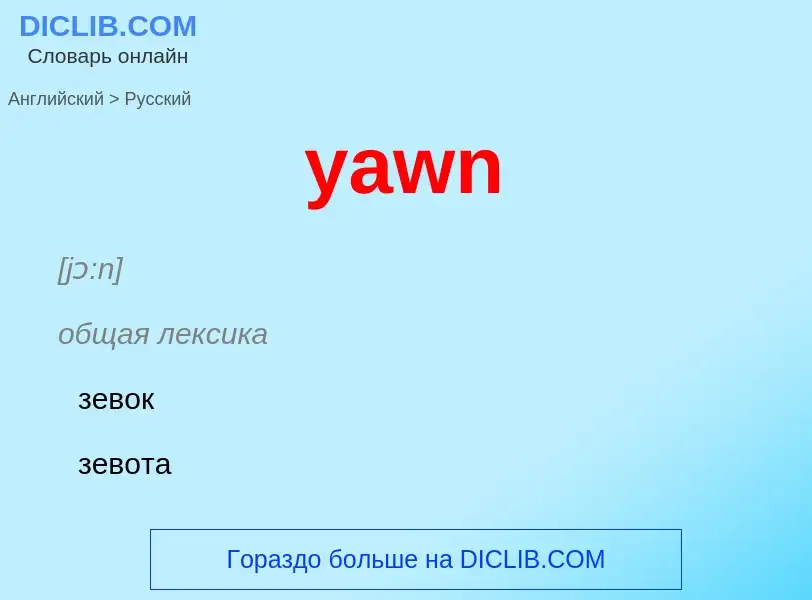Translation and analysis of words by ChatGPT artificial intelligence
On this page you can get a detailed analysis of a word or phrase, produced by the best artificial intelligence technology to date:
- how the word is used
- frequency of use
- it is used more often in oral or written speech
- word translation options
- usage examples (several phrases with translation)
- etymology
yawn - translation to russian
[jɔ:n]
общая лексика
зевок
зевота
зевать
Yet another UNIX nerd
зазор
люфт
просвет
существительное
[jɔ:n]
общая лексика
зевок
зевота
зияющее отверстие
поэтическое выражение
пропасть
бездна
техника
зазор
просвет
люфт
неплотное соединение
разговорное выражение
скучища
нечто нудное
зануда
скучный человек
глагол
общая лексика
зевать
говорить (что-л.) зевая
скучать
зиять
устаревшее выражение
раскрывать рот от изумления
возвышенное выражение
разверзать
разверзаться
Definition
Wikipedia
 - Self-Portrait, Yawning - Google Art Project.jpg?width=120)
A yawn is a reflex lasting 4–7 seconds, and is characterized by a long inspiratory phase with gradual mouth gaping, followed by a brief climax (or acme) with muscle stretching, and a rapid expiratory phase with muscle relaxation. For fish and birds, this is described as gradual mouth gaping, staying open for at least 3 seconds and subsequently a rapid closure of the mouth. Almost all vertebrate animals, including mammals, birds, reptiles, amphibians, and even fish, experience yawning. The study of yawning is called chasmology.
Yawning (oscitation) most often occurs in adults immediately before and after sleep, during tedious activities and as a result of its contagious quality. It is commonly associated with tiredness, stress, sleepiness, boredom, or even hunger. In humans, yawning is often triggered by the perception that others are yawning (for example, seeing a person yawning, or talking to someone on the phone who is yawning). This is a typical example of positive feedback. This "contagious" yawning has also been observed in chimpanzees, dogs, cats, birds, and reptiles and can occur between members of different species. Approximately twenty psychological reasons for yawning have been proposed by scholars but there is little agreement on the primacy of any one.
During a yawn, muscles around the airway are fully stretched, including chewing and swallowing muscles. Due to these strong repositioning muscle movements, the airway (lungs and throat) dilates to three or four times its original size. The tensor tympani muscle in the middle ear contracts, which creates a rumbling noise perceived as coming from within the head; however, the noise is due to mechanical disturbance of the hearing apparatus and is not generated by the motion of air. Yawning is sometimes accompanied, in humans and other animals, by an instinctive act of stretching several parts of the body including the arms, neck, shoulders and back.

 - Self-Portrait, Yawning - Google Art Project.jpg?width=200)

![''Two women ironing'', one with a yawn, by [[Edgar Degas]] ''Two women ironing'', one with a yawn, by [[Edgar Degas]]](https://commons.wikimedia.org/wiki/Special:FilePath/Edgar Germain Hilaire Degas 084.jpg?width=200)
![A soldier hides his yawn from his lady companion in this detail from a painting by [[Oscar Bluhm]] titled ''Ermüdende Konversation'', or "Wearisome conversation". A soldier hides his yawn from his lady companion in this detail from a painting by [[Oscar Bluhm]] titled ''Ermüdende Konversation'', or "Wearisome conversation".](https://commons.wikimedia.org/wiki/Special:FilePath/Oscar Bluhm Ermüdende Konversation crop.jpg?width=200)

